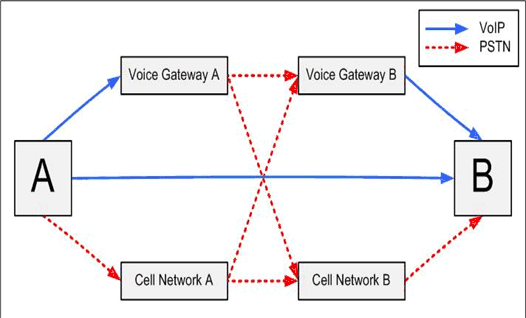 Important: Important: |
|---|
| This is retired content. This content is outdated and is no longer being maintained. It is provided as a courtesy for individuals who are still using these technologies. This content may contain URLs that were valid when originally published, but now link to sites or pages that no longer exist. |
The following illustration shows the different paths voice data can take between two dual mode (cellular and VoIP) phones. The two phones in the illustration are on separate cell networks and on separate IP PBXs. The solid blue arrows denote VoIP connections, and the dashed red arrows denote PSTN and cellular connections.

There are five unique paths through the figure. The factors that determine which path is employed for a particular call are:
- Connection Mode setting or Network Preferences setting. This
setting specifies whether an outgoing call is placed through the
voice gateway or the cellular network, based upon factors like the
availability of preferred wireless networks and time of day.
- Destination phone number. In many deployments, phones will have
separate VoIP and cellular phone numbers. A phone call is
ultimately routed through the PSTN and to either the IP PBX (for a
VoIP call) or the cellular network’s PBX (for a cellular call). It
is possible to place a call over IP that is received as a cellular
call. The path for such a call would be A->Voice Gateway
A->Cell Network B->B.
- Peer-to-peer call. A call that is placed directly to another
VoIP device (typically using SIP URI) is routed directly to the
device. The path is simply A->B. Features such as Push-to-talk
will only work on peer-to-peer calls.
There are a number of variations of the above figure. When there is only one shared voice gateway, and therefore only one IP PBX, the IP PBX will allow the phones to set up a peer-to-peer call. The path for such a call is simply A->B.
Customized cellular features, such as push-to-talk over cellular, will only work when there is only one shared cellular network. The path for such a call is A->Cell Network->B.
The call recipient, B, can automatically forward missed VoIP calls to cell. To do this, the IP PBX for B must be configured such that if B cannot be reached over IP, an incoming call is automatically forwarded to B’s cell number. This configuration results in fewer missed calls if B is frequently out of WiFi range. The path for such a call is A->Voice Gateway A->Voice Gateway B->Cell Network B->B or A->Cell Network A->Voice Gateway B->Cell Network B->B.
If the voice gateway and cellular network are run by the same provider, the routing of the call to either IP or cell can be based on the presence information provided by the call recipient (B). This means B can have a single phone number (rather than one each for VoIP and cellular). It also means that call routing would not necessarily occur based on the destination phone number or SIP URI.








 See Also
See Also